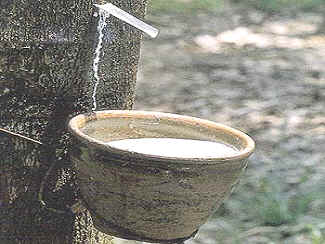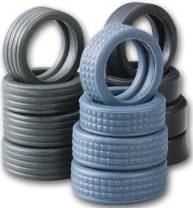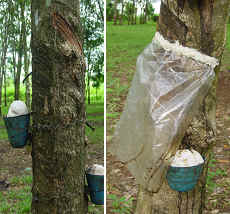
Philippine Postharvest Industry Profile: RUBBER
![]()
|
|
Philippine Postharvest Industry Profile: RUBBER
|
Based on the source of raw material, there are two kinds of rubber: natural rubber (NR) and synthetic rubber (SR).
Natural Rubber
extracted from plants
many plant species that produce natural rubber and there are many other plants that contain rubber latex
for quality and economic considerations, there is one major source of natural rubber which is the rubber tree (Hevea brasiliensis)
Synthetic Rubber
derived from petroleum, coal, oil, natural gas and acetylene
has over a dozen major classes, many of them are copolymers i.e. polymers consisting of more than one monomer
the earliest synthetic rubbers were the Styrene-butadiene copolymers (SBR) which, to this day, is the most commonly used elastomer.
serves as a substitute for natural rubber in many cases, especially when improved material properties are needed
This webpage mainly covers natural rubber being an agricultural commodity that has significant role in the economy of developing countries such as the Philippines.
Production of Natural Rubber
Natural rubber is produced entirely in developing countries and over 20 million families are dependent on rubber cultivation for their basic source of income.
Asia is the largest producer of natural rubber, accounting for around 94% of output in 2005.
The three largest producing countries (Indonesia, Malaysia and Thailand) together account for around 72% of all natural rubber production (http://en.wikipedia.Org/wiki/ Rubber, wikipedia).
Utilization of Natural Rubber
About 10 per cent of latex extracted from the rubber tree, Hevea brasiliensis, is manufactured into latex products
The remaining 90 per cent of latex is converted into dry rubber
Most natural rubber is dried by using a limited amount of fossil fuel. In general terms, dry natural rubber requires the use of about a tenth of the fossil fuel required to produce synthetic rubbers. Furthermore, the rubber tree is capable of reabsorbing the carbon dioxide generated by burning discarded rubber products, such as gloves and tyres
World Production Statistics and Projections
The volume of production was 6.8 million tons during 1998-2000, which is projected to reach 7.9 million tons in 2010.
The annual growth rate would be 1.3 percent in the current decade, which is significantly below the 2.9 percent during the past decade.
It is projected that total production in Asia would reach 6.8 million tons by 2010, more than 85 percent of world output, with an annual growth rate of 1 percent.
Slow growth rate may be due to the following:
further contraction in Malaysia and Sri Lanka, which have made efforts to diversify to more remunerative crops
expansion would be less rapid in almost all countries except Vietnam
Compared to 2001, production in Thailand would even decline
areas planted in the 1980's are now due for replanting and thus will be out of production for around six years
the rate of replanting natural rubber is declining as farmers and land shift to other employment because of the low prices seen in recent years
there is not much new planting seen
Thailand is expected to retain its position as the world’s largest supplier to produce 2.2 million tons by 2010
In Indonesia, production should grow 2.2 percent annually to reach 2.05 million tons by 2010
Production in other major producing countries such as China and India experience little growth
Vietnam and the Philippines are likely to see their production grow annually by 4 and 5.9 percent respectively, to double their output by 2010
Africa is expected to continue to increase its production to nearly 0.5 million tons with an annual growth rate of 2.2 percent which is slightly higher than 1.8 percent in the previous decade
Uses (http://en.wikipedia.org/wiki/Rubber, wikipedia)
The use of rubber is widespread, ranging from household to industrial products
Tires and tubes are the largest consumers of rubber, accounting for around 56% total consumption in 2005
high performance, notably aircraft and truck tires
The remaining 44% are taken up by the general rubber goods (GRG) sector, which includes all products except tires and tubes
Other significant uses of rubber are:
door and window profiles, hoses, belts, matting, flooring and dampeners (anti-vibration mounts) for the automotive industry in what is known as the "under the bonnet" products
gloves (medical, household and industrial), toy balloons, rubber bands
natural rubber latex has even been successfully implanted into the human pancreas
the principal glove producing countries are Malaysia, Thailand, China, India and the USA
adhesives in many manufacturing industries and products, although the two most noticeable are the paper and the carpet industry
textile industry
Philippine Statistics
The Philippines ranks 6th in world rubber production.
The total plantation area of more than 80 thousand hectares is located in Mindanao.
North Cotabato has the largest area planted to rubber tree, accounting at least 27 percent of the total area planted in the country. However, North Cotabato ranks 3rd in terms of volume of latex produced, with Zamboanga Sibugay leading the production with at least 27 percent contribution
The present level of rubber production supplies only 40% of the average domestic consumption
The present domestic consumption of rubber is 160,000 – 180,000 tons and is expected to increase to 250,000 tons in 2010. Demand is increasing by 15%-20% annually. It is projected that due to the slow rate of replanting and new planting programs, the Philippines will experience shortage of about 20,000 – 30,000 tons of natural rubber annually
Employment Generation
the industry operates more than 31,000 production units, employing nearly 75,000 people
75% of the rubber farmers are small-holders operating from 2 to 5 hectares
The manufacturing sector, although only about 160 in recent count, employs almost 15,000 people, or an equivalent of more than 90 people employed per manufacturing establishment
Local Products
|
PRODUCT DESCRIPTION |
COVERAGE |
|
Natural
rubber |
Natural rubber; balata; guttapercha; guayole; chicle and similar gums, in primary forms (including latex) or in plates, sheets or strips |
|
Rubber
tires Materials
of rubber Rubber
articles |
Paste,
sheets, rods, thread, tubes of rubber, bottle nipples, conveyor and
transmission belts, stoppers, plugs and seals, gaskets, weather-strips |
|
Rubber
footwear |
Shoes,
slippers, sandals |
Major
manufacturers of rubber products
|
PRODUCT |
MANUFACTURER |
|
TIRES
Auto/Truck Motorcycle/Bicycle |
Goodyear
Philippines, Inc. MSF
Tire and Rubber, Inc. Johnson
Mfg. Company, Inc. Manhattan
Rubber and Plastics Manufacturing First
Solid Rubber Industries, Inc. |
|
Materials
of Rubber |
Manila
Rubber Corporation Power
Synthetic Rubber Manufacturing Corporation Marcelo
Tire and Rubber Corporation Laguna
Rubber Company, Inc. Suyosa
Corporation NVPAS
Recapping |
|
Articles
of Rubber |
Latex
Products Company Evenflo
Philippines, Inc. Pioneer
Elastic Thread Corporation Mitsuboshi
Belting Philippines Corporation Transworld
Rubber Industrial Mfg Corporation J.P.
Aoki Rubber Philippines, Inc. Crislin
Rubber Products Dunlop
Slazenger Philippines, Inc. |
|
Rubber
Footwear |
Filcon
Mfg. Corporation New
Olympian Rubber Products Company Paramount
Vinyl Products Corporation |
Local Products
 70% of total natural rubber production goes to the
tire industry and construction works (roads, bridges, buildings, sports race
tracts, etc.)
70% of total natural rubber production goes to the
tire industry and construction works (roads, bridges, buildings, sports race
tracts, etc.)
30% goes to non-tire
products such as gloves, medical wares, sports wares, shoes, balls,
rubberwood for floor tiles, furniture, plywood, cabinets, and toys
Rubber
is sold by producers in the form of fresh latex, centrifuge latex, coagulum,
cuplumps, sheets and in block processed forms. The major players in moving
rubber from production sites to manufacturing sites are small and large
assemblers.
Export and Import
The Philippine rubber industry exports about 40% of its natural rubber production. Malaysia, China and Singapore are the country’s major export markets
Philippine imports of natural is minimal, recorded at 572 tons in 1996. Imports could increase in coming years with the decline in domestic rubber production and establishment of new rubber factories
Philippine
exports of natural rubber, 1992 - 1996
|
YEAR |
NATURAL
RUBBER (US
dollars) |
RUBBER
PRODUCTS (US
dollars) |
|
1996 1995 1994 1993 1992 |
12
049 793 9
345 614 33
815 737 27
817 530 13
598 517 |
61
481 873 20
414 389 82
444 620 67
051 419 60
286 306 |
Postharvest and Handling
Harvesting and handling
 Rubber
latex by “tapping”
Rubber
latex by “tapping”
Tapping may start on the 5th or 6th year after planting the rubber trees
Tapping starts at about 2 ½-3 ft. from the ground level
Rainguards or rainskirts are used to protect the latex while being harvested
Machineries and Equipment for Latex Processing
Locally manufactures village- level latex processing equipment for the production of air dried rubber sheets (ADS):
one-pair roller sheeter
cabinet type rubber dryer
jack-assisted presser
Issues and Concerns of the Philippine Rubber Industry
Small rubber farmers does not have the technical know-how of producing quality rubber. Their produce, the cuplump, is the lowest form of marketable rubber
No long-term viable and affordable loan schemes
Natural rubber commodity receives lower government priority support
REFERENCES:
Callano, Reynaldo S, PhD. July 2006. Village Level Rubber Latex Processing. Philippine Industrial Crops Research Institute, University of Southern Mindanao, Kabacan, Cotabato.
Callano, Reynaldo S, PhD. August 2006. Large Scale Latex Latex Processing. Philippine Industrial Crops Research Institute, University of Southern Mindanao, Kabacan, Cotabato.
Callano, Reynaldo S, PhD. August 2006. Tapping Systems and Latex Stimulation.. Philippine Industrial Crops Research Institute, University of Southern Mindanao, Kabacan, Cotabato.
Gabronino, Gloria L, PhD. July 2006. Marketing of Natural Rubber. University of Southern Mindanao.
Please check these pages often for updates. Brought to you by the
Planning and Evaluation Department
Bureau of Postharvest Research and Extension
CLSU Compound, Science City of Muñoz 3120 Nueva Ecija, Philippines
Your
suggestions, comments and ideas are welcome. Please write to the web
author: ![]()
Copyright © 2007 BPRE. All rights reserved.